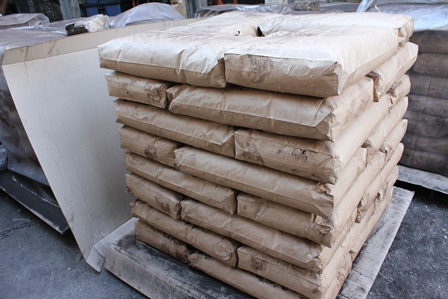Cementing

Description of Gilsonite in Oil and Gas Well Cementing
Gilsonite,a solid hydrocarbon, is the same bitumen extracted from mines.since gilsonite was Introduced to the oil Industry in August 1957 as a cement additive , over 200 jobs have been performed using the material. This mineral has so far been discovered in the western mines of Iran. This material is used in the preparation of isogam, insulation of water pipes, making waxes and asphalt, drilling of oil wells and providing printer ink, etc.
The Role of Gilsonite in Cementing
As the oil-producing industry has continued to grow, the need for a low-density cementing slurry possessing lost-circulation control characteristics has become more and more evident.. This is especially so In primary cementing because of the different types of formations being encountered and the need to reduce remedial cementing operation These problem formations may range from either porous or cavernous formations to very weak formations that are unable to support the hydrostatic head that is necessary for drilling and well completion. This latter type of formation will often break down or fracture under hydrostatic loading, resulting In partial or complete loss of circulation.
Lost-circulation zones encountered during drilling operation may produce many problems In the normal course of completing a well. Increased expenditures can result from reduced drilling finishing jobs, and other mechanical difficulties as well as from loss of large volumes of drilling fluid . Sometimes severe lost-circulation problems may even cause abandonment of a well. Lost circulation during cementing operations will often be reflected by inadequate fill-up In the annulus and the consequent displacement of slurry into formations away from the well bore. Satisfactory isolation of the different formations may then require re-cementing work above the point of loss and subsequent squeeze-cementing jobs.
For more than 50 years, the industry has depended on Gilsonite as a lost circulation material and a critical component for primary cementing operations in some of the world’s toughest drilling environments. Gilsoite is a special type of solid hydrocarbon(asphaltite) used with cement to reduse slurry weight and minimize lost circulation.
Gilsonite is used in cementing slurries to provide density control, scouring action for mud removal, and to support compressive strength development. It has a unique reaction with shale that improves cement bond development and strength.The wellbore is the primary hole on which the final well will be made.
Also, wellbores can be encased by steel or cement or in some cases, depending on the situation, may not be encased.In oil wells, it is necessary to encase the wellbore by cement. Adding the Gilsonite material during oil well cementing enhances the isolation characteristics while decreasing the vertiginous Gas flows. These characteristics can result in more effective mud removal which also enhances the environmental factors. Drilling environmental regulations are getting more and stricter around the world.
Gilsonite-A Unique Additive for Oil-well Cements

The unique properties of Gilsonite such as low specific gravity, particle-size distribution, impermeability, resistance to corrosive fluids, chemical inertness, and low water requirements result in a slurry having exceptional bridging properties, low slurry weight, compatibility with other slurry additives, and relatively high compressive strength when compared to other slurries of the same weight. Gilsonite is used in drilling fluids to cement oil wells. This mineral is a unique and stabilized blend of Gilsonite grade used to provide optimal drilling mud to stabilize shale (oil well walls).
Adding Gilsonite during cementing operations enhances the characteristics that are critical to effectively it the casing, isolating hydrocarbon formations and preventing annular gas flow.
Gilsonite Lost-Circulation Additive
Gilsonite additive is an asphaltene hydrocarbon in granular form. Its particle size varies between 4 and 100 mesh. Gilsonite additive is commonly used to control lost circulation. It is effective at bottomhole temperatures (BHTs) between 60° and 230°F (16° and 110°C). Typical additive concentrations range from 5- to 50-lb/sk of cement. The low specific gravity of Gilsonite additive helps improve its ability to control lost circulation. However, this feature can also cause the additive to separate to the top of thin slurries and slurries containing dispersants. Adding 2% or more bentonite to the slurry will help prevent separation.
Gilsonite additive can provide the following benefits:
When perforated, it is shatter-resistant.
It does not significantly affect the setting time of cement.
Gilsonite additive can provide higher strength than heavier additives with high water requirements.
Successful primary cementing operations result in a cement sheath to bond and support casing and provide zonal isolation. Good zonal isolation helps prevent the loss of production, control inter-zonal flow and/or flow to the surface, reduce water production and improve confinement of stimulation treatments.
Gilsonite cementing benefits:
- Increasing cement function
- The weight of Slurry would be very lower
- prevent from spread of free waters
- will reduce water quantity of slurry
- reducing the mud quntity
- improving scours of wellbore
- preventing from wellbore rheology
Gilsonite cementing grade using for oil and gas well:
Gilsonite Cementing Grade is an effective ingredient in insulation and it would be recyclable in the environmental cycling, reducing the risk of environmental damage to a very high level.Today, following the very fundamental challenges of insulating deep wells during drilling, due to the use of a variety of chemicals to insulate the walls of the well, these chemicals are very harmful to the environment, which is why the environment’s supporters Has lived.
For many years, the drilling industry has used Gilsonite Cementing Grade as a basic and recyclable medium in the worst parts of the world to cement the walls of oil wells.Using Gilsonite as additive during the operation of wall cementing of oil wells its the biggest advantage will be that the Gilsonite will prevent the spread of gas and hydrocarbon to the environment.
Gilsonite eliminates the problem of penetrating free water in to the oil well hole
By controlling free water, Gilsonite helps stabilize slurry and eliminates the need for – and cost of – additional free-water-control agents. As a lost circulation material, it also improves zonal isolation by preventing water channeling on the upper side of the wellbore
Gilsonite, with its own improvement will helps stabilize the oil wells cementing, Gilsonite is flexible, variable, high endurance and non-porous, non-porous These properties makes Gilsonite able to be recoverable.
Analaysis of natural bitumen(Gilsonite)
| NO | TEST | RESULT | TEST METHOD |
| 1 | ASH CONTENT,WT% | 5 | ASTM-D3174 |
| 2 | MOISTURE CONTENT,WT | 1 | ASTM-D3173 |
| 3 | VOLATILE MATTER,WT% | 63 | ASTM-D3175 |
| 4 | SOLUBILITY IS CS2,WT% | 81 | ASTM-D4 |
| 5 | SPECIFIC GRAVITY @25C | 1.11 | ASTM-D3289 |
| 6 | NORMAL NEPTHAN INSOLUBLES,WT% | 79 | ASTM-D3279 |
| 7 | COLOR IS MASS | BLACK | ———————– |
| 8 | COLOR IN STREAK OR POWDER | BLACK | ———————– |
| 9 | SOFTENING POINT,C | 205 | ASTM-D36 |
| 10 | PENETRATION @25C | 0 | ASTM-D5 |
ELEMENT ANALYSIS
| 1 | CARBON,WT% | 84 | ASTM-D5291 |
| 2 | HYDROGEN,WT% | 7.1 | ASTM-D5291 |
| 3 | NITROGEN,WT% | 3.67 | ASTM-D5291 |
| 4 | OXYGEN,WT% | 3.1 | ASTM-D5291 |
| 5 | SULPHURE,WT% | 4 | LEGO(S)ANALYSER |

